Kudos!
Kudos to Stuart Edwards who left the comment below on the last blog ost.
January 23, 2024 at 11:09am
The relatively short focal length and the distance to the subject makes for the broad area in focus even at the wide aperture.
What’s Up?
Though it stopped raining for the IPT, the weather has been anything but typical San Diego sunshine. As lousy as the weather has been, the pelican photography has been the polar opposite — totally amazing, the best I have ever had in 35 years of photo visits. Right now, I have 7,416 un-editd images from the first two days of the IPT to go through. Monte Brown created more than 8000 images on Wednesday alone! There was so much flight and action on the main cliff that we opted to stay for five hours and skip the afternoon session.
You still have time to have your life changed and learn a ton by signing up soon for the second 2024 San Diego IPT (info below).
Today is Thursday 25 January 2024. I will be meeting Monte and Keith Solberg early for Day 3 of the first San Diego IPT.
Wherever you are and whatever you choose to do, I hope that you too have a great day.
Please remember to use the B&H links that are found on most blog pages and to use the BIRDSASART discount code at checkout when purchasing your new gear from Bedfords to get 3% back on your credit card and enjoy free second-day air FedEx. Please, also, consider joining a BAA IPT. You will be amazed at how much you will learn!
If an item — a Delkin flash card, or a tripod head — for example, that is available from B&H and/or Bedfords, is also available in the BAA Online Store, it would be great, and greatly appreciated, if you would opt to purchase from us. We will match any price. Please remember also to use my B&H affiliate links or to earn 3% cash back at Bedfords by using the BIRDSASART discount code at checkout for your major gear purchases. Doing either often earns you free guides and/or discounts. And always earns my great appreciation.
Save 15%!
If you’d like to try out a new lens, or if you need a lens for a specific trip or project (or for an IPT), LensRentals.com is the only way to go. To save 15%, simply click on the logo link above, arrange for your rental, and type in BIRDSASART15. If you type the gear you are looking for in the search box, it will pop right up. LensRentals.com offers affordable insurance. You can decline it, opt for LensCap: Damage Only, or select LensCap: Damage & Theft. Then hit PROCEED TO CHECKOUT. After you enter all of your info but before completing your order, be sure to scroll down to Promo Code box and enter the BIRDSASART15 code to save 15%.
I checked on renting a Sony FE 70-200mm f/2.8 GM OSS II lens for a week. The cost is only $122.00. LensCap: Damage Only coverage can be added for a very low $18.00. Going with LensCap: Damage & Theft would be $27.00. The shipping charge varies. They offer an interesting program called Lensrentals HD. By signing up for this shipping discount program ($99.00/year), you’ll get free Standard Shipping on all the orders you place.
Renting a Sony 600mm f/4 GM OSS lens for a week will cost you $536.00. The two coverage options come in at $76.00 or $114.00. Less your 15% discount when you enter the BIRDSASART15 code into the Promo Code box at checkout and enter the BIRDSASART15 codeine the Promo Code box at checkout to save 15%.
Remember, to save the 15% on your rental you must start your search by clicking on the logo above, or on this link: LensRentals.com


B&H
To ensure that I get credit for your B&H purchases, you can always click here. The tracking is invisible but greatly appreciated. And, you can use your PayBoo card. You must use the website to order. B&H will reopen on Fri April 14. Thanking me for the past 4000 educational blog posts could not be any easier and will not cost you one penny. Please shoot me your B&H receipt for major purchases.
Many folks have written recently stating that they purchased a Sony a1 from B&H and would like their free membership in the Sony 1 Info and Updates Group, a $150.00 value. When I check my affiliate account, their orders have not been there. When I let them know that they get credit for B&H purchases only if they use one of the many B&H affiliate links on the blog or begin their searches with this link, they are always disappointed. If in doubt, please contact me via e-mail and request a BH link. I am always glad to help and to guide you to the right gear.
Bedfords Simplified
Click here to start your search. Choose standard shipping, and when you get to the payment page, enter BIRDSASART in the discount code box and hit apply. You will be upgraded to free second day air Fed-Ex and receive 3% cash back on your credit card once your stuff ships. Either is greatly appreciated by yours truly.
Bedfords Amazing BAA Discount Policy
Folks who have fallen in love with Bedfords can now use the BIRDSASART coupon code at checkout to enjoy a post-purchase, 3% off-statement credit (excluding taxes and shipping charges) on orders paid with a credit card. The 3% credit will be refunded to the card you used for your purchase. Be sure, also, to check the box for free shipping to enjoy free Second Day Air Fed-Ex. This offer does not apply to purchases of Classes, Gift Cards, prior purchases.
Visit the Bedfords website here, shoot Steve Elkins an e-mail, or text him on his cell phone at (479) 381-2592.
Gear Questions and Advice
Too many folks attending BAA IPTs and dozens of photographers whom I see in the field and on BPN, are — out of ignorance — using the wrong gear, especially when it comes to tripods and more especially, tripod heads. And the same is true in spades when ordering new camera bodies or lenses. My advice will often save you some serious money and may help you avoid making a seriously bad choice. Please know that I am always glad to answer your gear questions via e-mail. If you are desperate, you can try me on my cell at 863-221-2372. Please leave a message and shoot me a text if I do not pick up.
|
|
|
This image was created on 24 January at La Jolla, CA on Day 2 of the first 2024 San Diego IPT. While seated on a dirt cliff I used the handheld Sony FE 70-200mm f/2.8 GM OSS II lens with the Sony FE 2x teleconverter (at 336mm), and The One, the Sony Alpha 1 Mirrorless Digital Camera.. The exposure was determined via Zebra technology with ISO on the Thumb Dial. ISO 1250: 1/2500 sec. at f/5.6 (wide open) in Manual mode. AWB at 11:30:48am on a cloudy morning. Zone AF/C with Bird-Eye/Face Detection performed perfectly. Click on the image to enjoy a high-res version. Breeding plumage adult Pacific-race Brown Pelican landing TIGHT — horizontal |
Midday Flight Photography
Midday flight photography is best done on cloudy days. With a gentle breeze from the northeast early on, there were dozens of pelicans flying in, but in the light wind, most were not high enough. The birds were 100% copasetic — head and shoulders portraits of gorgeous birds were there for the taking with any telephoto lens. We talked about isolation, AF, head throws, and exposure. At about 10:30 the wind switched to the SW and the intensity picked up so we turned around and faced north to photograph the pelicans flying in to land, many right in front of us. For most of the morning I used the 70-200 with either the 1.4X or the 2X TC.
While it is much easier to shoot flight with the camera oriented to horizontal capture, it is very difficult to frame the image as the bird approaches point-blank range without clipping the feet. I did that on about 300 images. I got very lucky with this bird as I mis-framed 22 of the 24 close-range shots. That after 33 more distant images of the same bird flying right at me from a distance. I should have realized soon that turning the camera on end and creating tight vertical flight originals was the best way to deal with clipping the feet. As below.
|
|
|
This image was also created on 24 January at La Jolla, CA on Day 2 of the first 2024 San Diego IPT. Again, while seated on a dirt cliff I used the handheld Sony FE 70-200mm f/2.8 GM OSS II lens with the Sony FE 2x teleconverter (at 400mm), and The One, the Sony Alpha 1 Mirrorless Digital Camera.. The exposure was determined via Zebra technology with ISO on the Thumb Dial. ISO 1600: 1/2500 sec. at f/5.6 (wide open) in Manual mode. AWB at 11:31:44am on a cloudy morning. Zone AF/C with Bird-Eye/Face Detection performed perfectly. Click on the image to enjoy a high-res version. 2-year old Pacific race Brown Pelican landing TIGHT — vertical original! |
Duh!
As I said above, shooting vertical originals of pelicans in flight at point blank range is the best way to go when the birds are flying right at you at point blank range. I wish that I had come to my senses sooner 🙂
The traditional use of this technique is when you are working in horizontal format photographing banking birds and clipping the wingtips; you switch to vertical and can then easily fit the banking birds in the frame without clipping the wingtips. Having a vertical grip on your camera body makes shooting vertical flight easier, but I hate the added weight so I sold mine a few moths ago. Without a grip, you simply rotate to your right 90° counter-clockwise and go to work.
|
|
|
San Diego offers a wealth of very attractive natural history subjects, including and especially the Pacific race of California Brown Pelican. With annual visits spanning more than four decades, I have lots of photographic experience there … Click on the composite to enjoy a larger version. |
The 2024 San Diego Brown Pelicans (and more!) IPTs
San Diego IPT #2: 3 1/2 DAYS: WED 31 JAN thru the morning session on SAT 3 FEB, 2024: $2149.00. Limit: 6 photographers/Openings 4.
Please e-mail for information on personalized pre- and post-IPT morning sessions.
Join me in San Diego to photograph the spectacular breeding plumage Brown Pelicans with their fire-engine red and olive green bill pouches; Brandt’s (nesting) and Double-crested Cormorants; breeding plumage Wood and Ring-necked Ducks; other duck species possible including Lesser Scaup, Redhead, Northern Shoveler and Surf Scoter; a variety of gulls including Western, California, and the gorgeous Heermann’s, all in full breeding plumage; shorebirds including Marbled Godwit, Willet, Sanderling and Black-bellied Plover; many others are possible including Least, Western, and Spotted Sandpiper, Whimbrel, Black and Ruddy Turnstone, Semipalmated Plover, and Surfbird; Harbor Seals and California Sea Lions (both depending on the current regulations and restrictions). And as you can see by studying the IPT cards, there are some nice bird-scape and landscape opportunities as well. Not to mention a ton of excellent flight photography opportunities and instruction.
I discovered some really neat new spots on my 2022/23 visit. As a result, the first and second IPTs may include an afternoon or two of landscape photography.
Please note: where permitted and on occasion, ducks and gulls may be attracted (or re-located) with offerings of grains or healthy bread.
|
|
|
San Diego offers a wealth of very attractive natural history subjects, including and especially the Pacific race of California Brown Pelican. With annual visits spanning more than four decades, I have lots of photographic experience there … Click on the composite to enjoy a larger version. |
Learning Exposure, Whether You Like It Or Not
Whether you like it or not, we will be beating the subject of exposure like a dead horse. In every new situation, you will hear my thoughts on exposure along with my thoughts on both Nikon and Canon histograms and SONY Zebras. Whether you like it or not, you will learn to work in manual mode so that you can get the right exposure every time (as long as a bird gives you ten seconds with the light constant). Or two seconds with SONY zebras … And you will learn what to do when the light is changing constantly. What you learn about exposure will be one of the great takeaways on every IPT.
|
|
|
Though the pelicans will be the stars of the show on this IPT, there will be many other handsome and captivating subjects in wonderful settings. Click on the composite to enjoy a larger version. |
It Ain’t Just Pelicans
With gorgeous subjects just sitting there waiting to have their pictures taken, photographing the pelicans on the cliffs is about as easy as nature photography gets. With the winds from the east almost every morning, there is usually some excellent flight photography, at times with 70-200mm lenses! And the pelicans are almost always doing something interesting: preening, scratching, bill pouch cleaning, or squabbling. And then there are those crazy head throws that are thought to be a form of intra-flock communication. You will be guided as to how to make the best of those opportunities. Depending on the weather, the local conditions, and the tides, there are a variety of other fabulous photo chances available in and around San Diego. Each IPT will include one or two duck sessions.
|
Did I mention that there are lots of great birds and natural history subjects in San Diego in winter? Click on the composite to enjoy a larger version. |
The San Diego Details
These IPTs will include four or five 3-hour morning photo sessions, three or four 1 1/2-hour afternoon photo sessions, and three or four working brunches that will include image review and Photoshop sessions. On rare cloudy days, we may — at the leader’s discretion, stay out in the morning for a long session and skip that afternoon shoot. To ensure early starts, breakfasts will be your responsibility. And so that we can get some sleep, dinners will be on your own as well. In the extremely unlikely event that Goldfish Point is closed due to local ordinance (or whimsy) — that has never happened in the past fifty years, I will of course do my very best to maximize our photographic opportunities.
Deposit Info
A $699 deposit is required to hold your slot for one of the 2024 San Diego IPT. You can send a check (made out to “BIRDS AS ART”) to us here: BIRDS AS ART, PO Box 7245, Indian Lake Estates, FL, 33855, or call Jim or Jennifer at the office with a credit card at 863-692-0906. Your balance, payable only by check, is due three months before the trip.
|
Variety is surely the spice of life in San Diego. Click on the composite to enjoy a larger version. |
Getting Up Early and Staying Out Late
On all BIRDS AS ART IPTS including and especially the San Diego IPT, we get into the field early to take advantage of unique and often spectacular lighting conditions and we stay out late to maximize the chances of killer light and glorious sunset silhouette situations. We often arrive at the cliffs a full hour before anyone else shows up to check out the landscape and seascape opportunities.
Typos
With all blog posts, feel free to e-mail or to leave a comment regarding any typos or errors.


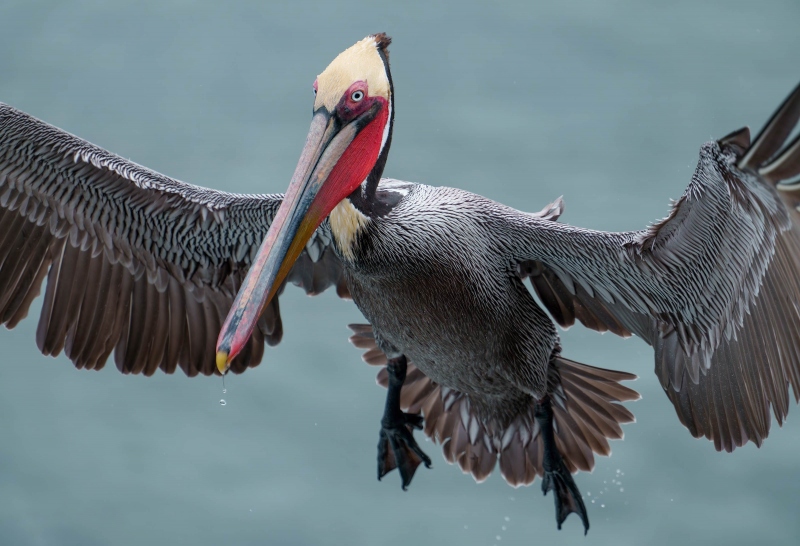
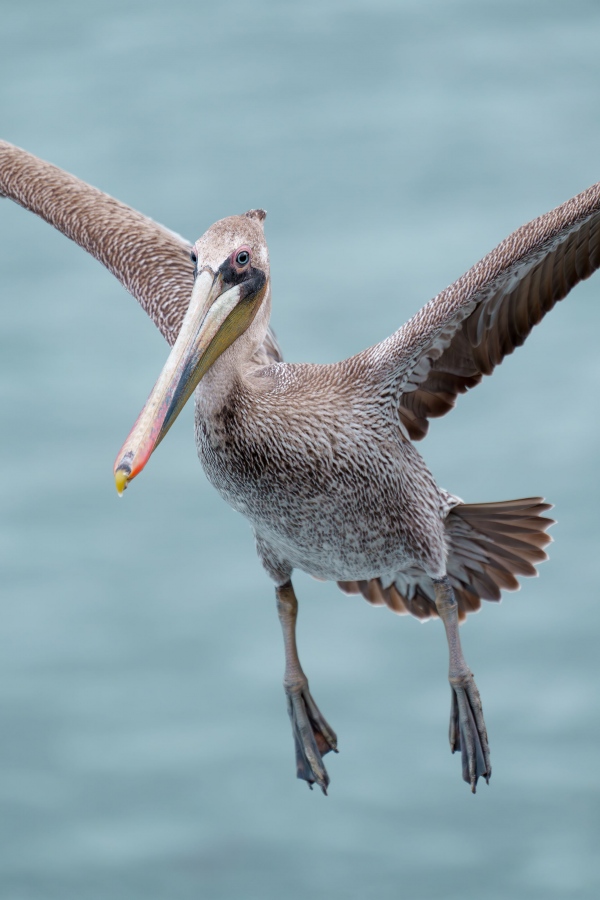
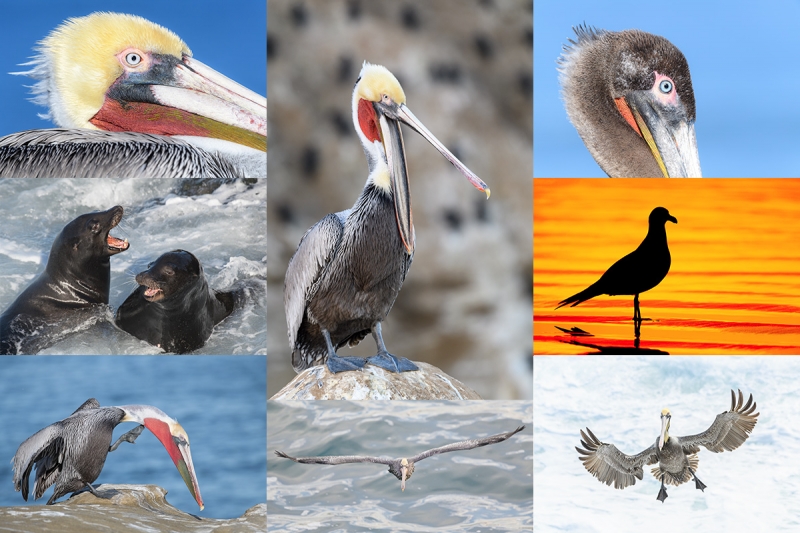
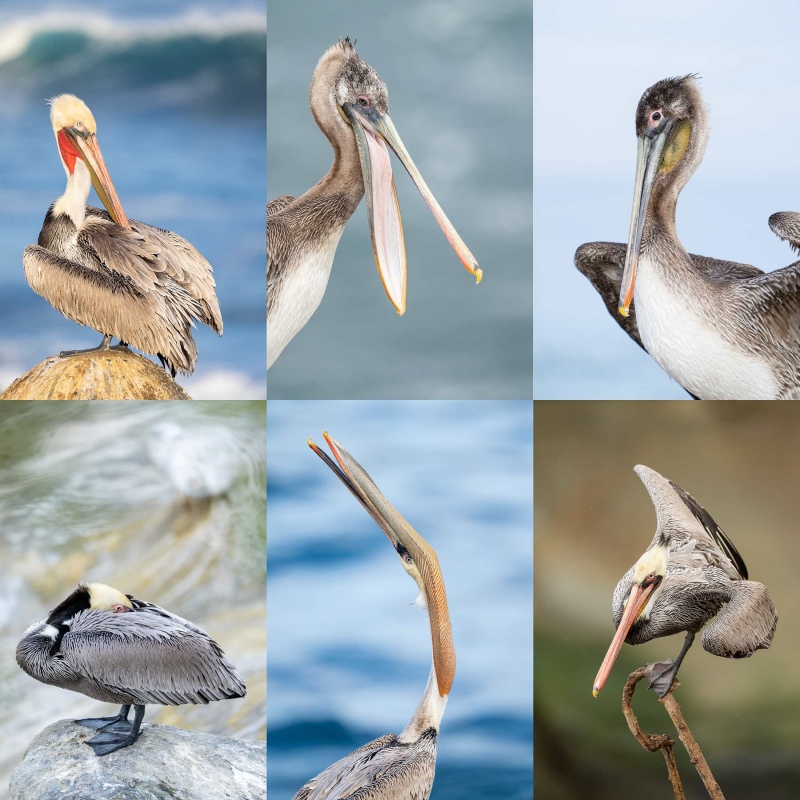
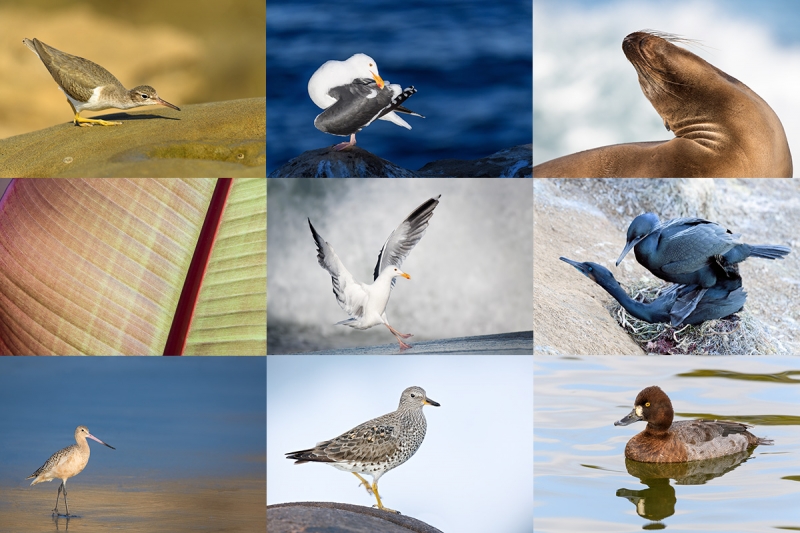















Horizontal looks better and the subject is better…duh right. Better rethink that grip!
Thanks for the advice, Jeff. But I will be ignoring it. See my reasoning in the next post.
I do agree that the bird in the first image was more colorful and more beautiful than the bird in the second image, but the image design of the vertical original is the far stronger of the two. For me.
with love, a
hi artie
just wanted to tell you had bufflehead ducks in the pond today 4 pairs
we also have al least 50 mallords this year
love ilene
I prefer the horizontal image.
Both 2 images of Brown Pelican are well made and interesting. All the other images of many birds also have Brown Pelican in it and are well made and good.
I think that the vertical is much better.
The horizontal image looks much better to my eye; the composition seems more balanced, the flow of the lines in and out of the photograph more pleasing (and the more colorful plumage on this pelican doesn’t hurt, either!). I also prefer the wing position on the first, as well as the water droplets below the feet. All in all, it’s just a stronger image.
Horizontal looks better IMO.
Regards.